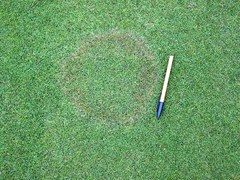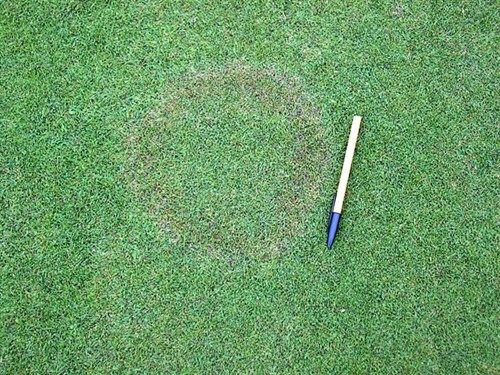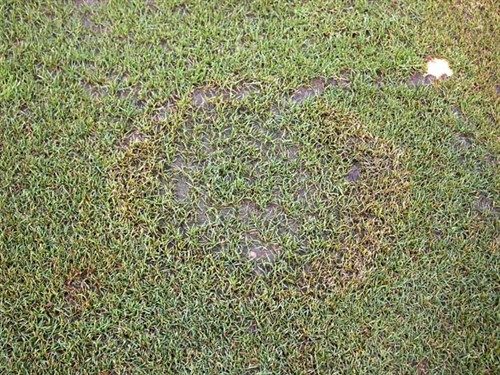
Thunderstorms trigger Brown Patch infection - June 2008
Rhizoctonia Brown Patch is very common in areas of the USA, Central and Southern European countries, where hot weather conditions are common. More recently outbreaks have been observed in the UK, especially where hot days trigger thunderstorms.
The infective pathogen, Rhizoctonia solani, inhabits the rootzone and, when weather conditions are hot enough for infection, may cause brown patch. Rhizoctonia spp. are also often found as a secondary infection or as a saprophyte following other diseases.
Fungicides should be applied at the very first sign of disease, since as Brown Patch can spread rapidly in conducive conditions. Banner MAXX (propiconazole) and Heritage (azoxystrobin) are both approved for Brown Patch control, along with other diseases occurring at the same time. Trials have shown Daconil Weather Stik (chlorothalonil) is also very effective against Brown Patch.

Rhizoctonia brown patch on close-mown bentgrass showing 'smoke-ring'
On close mown grass species (such as bentgrass) Brown Patch can initially be seen as patches of water soaked grass, which develop to become tan to dark brown. In humid conditions a brown/grey 'smoke ring' may develop around the edge of the patch (above). On grass species that are cut higher (such as tall fescue) a light brown patch forms. Individual leaves may have lesions that are tan in the centre and bordered with a brown edge (below).

Rhizoctonia on tall fescue
Rhizoctonia solani tends to affect grasses that are under stress, which is usually temperature related. The weather conditions most conducive to infection are daytime air temperatures over 20ºC (usually the high 20's), persistent humidity or leaf wetness and excessive fertility.
The formation of dew can encourage R. solani, as it uses the carbohydrates in guttation water as a food source. Dew removal is therefore very important to reduce the potential for the pathogen to grow and spread. The use of wetting agents to manage dew may also be considered.
Encouraging good air movement and early sunlight penetration to the grass surface will also help to reduce the time taken for surface moisture to dry. Thatch should be managed by aeration to prevent moisture retention on soil the surface. Avoid excessive nitrogen fertiliser, as lush grass is more easily infected by R. solani.
Where irrigation is required, apply as close to dawn as possible to prevent the surface remaining wet for longer than necessary. Research has shown brown patch was more severe in plots watered in the evening, compared to those watered in the morning - especially in hot weather.
